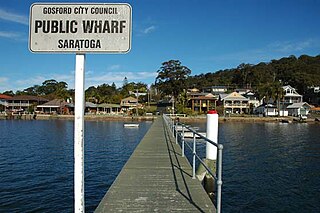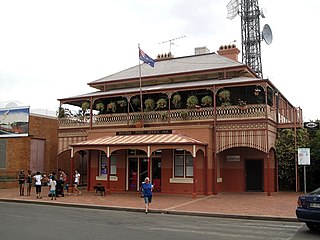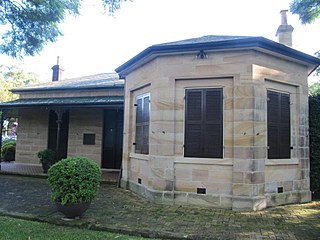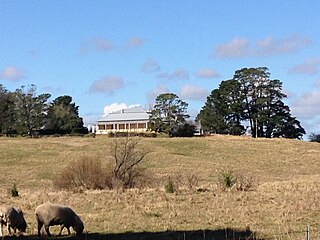
Saratoga is a residential south-eastern village and suburb of the Central Coast region of New South Wales, Australia, located on a peninsula of Brisbane Water and part of the Central Coast Council local government area. The suburb is characterised by its largely settled shoreline, with houses extending up coastal slopes to the base of the tall hills that comprise the core of the peninsula.

Experiment Farm Cottage is a heritage-listed former farm and residence and now house museum at 9 Ruse Street, Harris Park, City of Parramatta, Sydney, Australia. It is one of Australia's oldest standing residences, being built in c. 1834. It is located at the site of Experiment Farm, Australia's first European farmstead, which was itself created by Australia's first land grant. It was added to the New South Wales State Heritage Register on 2 April 1999.

Cooma Cottage is a heritage-listed former farm and tuberculosis sanatorium and now house museum and historic site in the Southern Tablelands region of New South Wales in Australia. It is located on Yass Valley Way at Marchmont and was built from 1830 to 1837 by Cornelius and Rebecca O'Brien. It is also known as Hamilton Hume's House,Humedale Stud, and New Nordrach Institute for Consumption. The property is owned by the National Trust of Australia (NSW). It was added to the New South Wales State Heritage Register on 1 March 2002.

Orange railway station is a heritage-listed former railway bridge and now railway station located on the Main Western line on Paisley Street, Orange in the City of Orange local government area of New South Wales, Australia. It was built from 1877 to 1950. It is also known as Orange Railway Station and yard group. The property was added to the New South Wales State Heritage Register on 2 April 1999.

Oakwal is a heritage-listed villa at 50 Bush Street, Windsor, City of Brisbane, Queensland, Australia. It was designed by architect James Cowlishaw and built in 1864 by John Petrie with subsequent modifications to c. 1948. It was added to the Queensland Heritage Register on 14 May 1993.

Bourke Post Office is a heritage-listed post office at 47 Oxley Street, Bourke, in the Orana region of New South Wales, Australia. It was designed by the Colonial Architect's Office under James Barnet and built in 1880 by E. Heseler. It is also known as Bourke Post and Telegraph Office. The property is owned by the Keane Family Trust. It was added to the New South Wales State Heritage Register on 23 June 2000.

Ardsilla is a heritage-listed house at 5 Richard Street, Bourke, in the Far West region of New South Wales, Australia. It has also been known as Brigalow and was briefly the Brigalow Private Hospital. It was added to the New South Wales State Heritage Register on 2 April 1999.

The Royal Oak Inn is a heritage-listed hotel located on the corner of Windsor Road and Commercial Road, in Rouse Hill in The Hills Shire local government area of New South Wales, Australia. It was built in 1829. It has also been known as the Queens Arms Inn, and is currently known as the Fiddler Hotel. The property is privately owned and was added to the New South Wales State Heritage Register on 2 April 1999.
Box Hill House is a heritage-listed former hunting grounds and farm estate and now residential support home at 10 Terry Road, Box Hill, New South Wales, a suburb of Sydney, Australia. It was built from 1819 to 1897 by Samuel Terry and George Terry. It is also known as McCall Garden Colony, Box Hill House in grounds of McCall gardens, McCall Gardens and Box Hill estate. The property is privately owned. It was added to the New South Wales State Heritage Register on 2 April 1999.

Essington is a heritage-listed former gentleman's residence and farm estate and now independent school located at 2, 4, 6, and 8 Bridge Road, Westmead in the Cumberland Council local government area of New South Wales, Australia. It was built from 1860 to 1890. It is also known as Essington Christian Centre; Westmead Christian Grammar School. The property is owned by Church of the Foursquare Gospel. It was added to the New South Wales State Heritage Register on 2 April 1999.

Marika is a heritage-listed residence located at 46 Ryde Road, Hunters Hill in the Municipality of Hunter's Hill local government area of New South Wales, Australia. It was built during 1904. It is also known as Rye. It was added to the New South Wales State Heritage Register on 2 April 1999.
Little Milton is a heritage-listed residence at 31–33 Smith Street, Wollongong, City of Wollongong, New South Wales, Australia. It was built from 1830 to 1850. It was added to the New South Wales State Heritage Register on 2 April 1999.

Carisbrook is a heritage-listed former private residence and now house and local history museum at 334 Burns Bay Road, Lane Cove, Sydney, Australia. It was built during 1884. The property is owned by Lane Cove Council.

Throsby Park is a heritage-listed homestead at Church Road, Moss Vale, Wingecarribee Shire, New South Wales, Australia. It was built from 1820 to 1836. The property is owned by the Historic Houses Trust of New South Wales, but is leased to banker Tim Throsby of Barclays, a descendant of the original owners. It was added to the New South Wales State Heritage Register on 2 April 1999.

Davisville is a heritage-listed former YWCA women's home, residence and commune and now residence and bed and breakfast at 63-67 Falls Road, Wentworth Falls, City of Blue Mountains, New South Wales, Australia. It was built from 1888 to 1920 by David Davis, Sydney builder. It is also known as Rennie House. It was added to the New South Wales State Heritage Register on 2 April 1999.

Raywell is a heritage-listed residence at 144 Louisa Road, Birchgrove, Inner West Council, Sydney, New South Wales, Australia. It is also known as Carnegie House. It was added to the New South Wales State Heritage Register on 2 April 1999.

Sugarloaf Farm is a heritage-listed former dairy, wheat farming and pastoral property and now residence and horse riding venue located at Menangle Road, Gilead, City of Campbelltown, New South Wales, Australia. It was designed and built from 1835. It is also known as Mt Huon. The property is owned by the New South Wales Department of Planning and Infrastructure. It was added to the New South Wales State Heritage Register on 2 April 1999.
Cox's Cottage is a heritage-listed pasturing land and residence located at 2 St Thomas Road in the western Sydney suburb of Mulgoa in the City of Penrith local government area of New South Wales, Australia. It was built from 1810 to 1811 by James King. It is also known as Mulgoa Cottage; The Cottage, Coxs Cottage, and was formally known as Fern Hill and Estate of Mulgoa before the new house was built. The property remains privately owned and is the oldest house in Australia still in residence. It was added to the New South Wales State Heritage Register on 2 April 1999.

The 203–205 Albion Street, Surry Hills Cottages are two heritage-listed cottages located at 203–205 Albion Street in the inner city Sydney suburb of Surry Hills in the City of Sydney local government area of New South Wales, Australia. It was built in 1840 by George Hill. The property is owned by the Royal College of Pathologists of Australasia. It was added to the New South Wales State Heritage Register on 2 April 1999.

Old Pyrmont Cottages is a heritage-listed cottage at 1, 3, 5 Cross Street in the inner city Sydney suburb of Pyrmont in the City of Sydney local government area of New South Wales, Australia. It was built from 1879 to 1895. It is also known as Cross & Scott Street Terraces. The property is owned by the Sydney Harbour Foreshore Authority (SHFA). It was added to the New South Wales State Heritage Register on 25 August 2017.




















